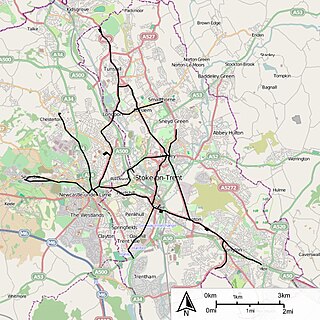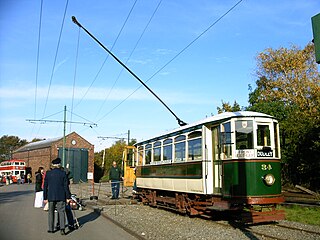
The Melbourne cable tramway system was a cable car public transport system, which operated between 1885 and 1940 in Melbourne, Victoria, Australia.

Melbourne tram route 1 is operated by Yarra Trams on the Melbourne tram network. It operates from the corner of Nicholson and Bell Streets in East Coburg to the corner of Victoria Avenue and Beaconsfield Parade at South Melbourne Beach. The 13.2 kilometre route is operated by Z3 and B2 class trams from Brunswick depot.
The Mexborough & Swinton Tramways Company was a tramway system in South Yorkshire, England, founded in 1902 and which began services in 1907 linking Rotherham with the Old Toll Bar, Mexborough. Its routes served Manvers Main Colliery, Wath upon Dearne and the towns of Rotherham, Rawmarsh, Swinton and Mexborough.

Until 1958, trams formed a network spanning most of Adelaide, with a history dating back to 1878. Adelaide ran horse trams from 1878 to 1914 and electric trams from 1909, but has primarily relied on buses for public transport since 1958. Electric trams and trolleybuses were Adelaide's main public transport throughout the life of the electric tram network. All tram services except the Glenelg tram line were closed in 1958. The Glenelg tram remains in operation and has been progressively upgraded and extended since 2005.
Edinburgh Corporation Tramways formerly served the City of Edinburgh, Scotland. The city used four-wheeled double-decked trams painted dark red (madder) and white – a livery still used by Lothian Buses and the post-2014 Edinburgh Trams.
Grimsby electric railway station was the eastern terminus of the Grimsby and Immingham Electric Railway, the western terminus being Immingham Dock, 7 miles (11 km) to the north west.
Trams operated in Edinburgh from 1871 to 1956, and resumed in 2014. The first systems were horse-drawn, while cable-haulage appeared in the city in 1888. Electric trams first ran on systems in neighbouring Musselburgh (1904) and Leith (1905), meeting the Edinburgh cable-trams at Joppa and Pilrig respectively. Electrification meant cable trams last ran in 1923, with through running now possible to Leith and as far east as Port Seton. The various systems were operated by different private and municipal entities over the years; the Edinburgh and Leith systems had been merged under Edinburgh Corporation by 1920, but it wasn't until 1928, after the partial closure of Musselburgh line, that all trams operating in Edinburgh were in the sole control of the corporation. The last electric trams ran in 1956, but electric trams returned in 2014 with the opening of Edinburgh Trams. Many of the trams from the horse/cable/first electric era were built in Shrubhill Works. Two trams have been preserved, a horse tram and an electric tram, built by Shrubhill in 1885 and 1948 respectively. A 1903 Dick Kerr cable-tram has also been purchased for preservation. Remnants of the cable-tram system can be seen in Waterloo Place and Henderson Row, and of the Musselburgh line at Morrison's Haven.

The Tynemouth and District Electric Traction Company operated a tramway service in North Shields, Tynemouth and Whitley Bay between 1901 and 1931.

The Llandudno and Colwyn Bay Electric Railway operated an electric tramway service between Llandudno and Rhos-on-Sea from 1907 and extended to Colwyn Bay in 1908. The service closed in 1956.

The Leamington & Warwick Tramways & Omnibus Company operated a tramway service between Warwick and Leamington Spa between 1881 and 1930.
The Worcester Electric Traction Company operated a tramway service in Worcester between 1904 and 1928.

The Potteries Electric Traction Company operated a tramway service in The Potteries between 1899 and 1928.

The City of Oxford and District Tramway Company and its successor the City of Oxford Electric Traction Company operated a horse-drawn passenger tramway service in Oxford between 1881 and 1914. The tramway was unusual for having a track gauge of only 4 feet (1.219 m).
Rawtenstall Corporation Tramways operated a passenger tramway service in Rawtenstall between 1908 and 1932.

The Wolverhampton District Electric Tramways Company operated an electric tramway service between Dudley and Wolverhampton between 1899 and 1928.

Ayr Corporation Tramways operated an electric tramway service in Ayr between 1901 and 1931.
Llanelly and District Electric Tramways operated a standard gauge tramway service in Llanelli, Wales, between 1908 and 1933. It was the successor to a 3 ft gauge horse tramway, which ran from 1882 until 1908. A complex series of negotiations took place in the early 1900s, resulting in the horse tramway being converted to an electric tramway. Standard gauge horse trams were run initially, until the company completed North Dock power station, which supplied electricity to the tramway. Two of the employees who worked on the construction went on to found Balfour Beatty.
The Pontypridd and Rhondda Valley Tramway operated a tramway service in Pontypridd and Porth between 1888 and 1902.

The Port Seton Professional Tournament was a professional golf tournament played at Port Seton on 1 June 1914 to promote the new golf course. George Duncan won the event by two shots from J.H. Taylor.










